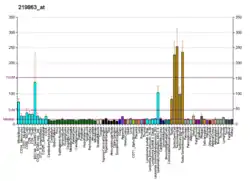HERC5
Probable E3 ubiquitin-protein ligase HERC5 is an enzyme that in humans is encoded by the HERC5 gene.[3][4]
This gene is a member of the HERC family of ubiquitin ligases and encodes a protein with a HECT domain and five RCC1 repeats. Pro-inflammatory cytokines upregulate expression of this gene in endothelial cells. The protein localizes to the cytoplasm and perinuclear region and functions as an interferon-induced E3 protein ligase that mediates ISGylation of protein targets. The gene lies in a cluster of HERC family genes on chromosome 4.[4] HERC5 has been shown to exhibit antiviral activity towards HIV-1, influenza A virus and human papillomavirus.[5][6][7]
References
- GRCh38: Ensembl release 89: ENSG00000138646 - Ensembl, May 2017
- "Human PubMed Reference:". National Center for Biotechnology Information, U.S. National Library of Medicine.
- Mitsui K, Nakanishi M, Ohtsuka S, Norwood TH, Okabayashi K, Miyamoto C, Tanaka K, Yoshimura A, Ohtsubo M (Jan 2000). "A novel human gene encoding HECT domain and RCC1-like repeats interacts with cyclins and is potentially regulated by the tumor suppressor proteins". Biochem Biophys Res Commun. 266 (1): 115–22. doi:10.1006/bbrc.1999.1777. PMID 10581175.
- "Entrez Gene: HERC5 hect domain and RLD 5".
- Woods MW, Kelly JN, Hattlmann CJ, Tong JG, Xu LS, Coleman MD, Quest GR, Smiley JR, Barr SD (Nov 2011). "Human HERC5 restricts an early stage of HIV-1 assembly by a mechanism correlating with the ISGylation of Gag". Retrovirology. 8: 95. doi:10.1186/1742-4690-8-95. PMC 3228677. PMID 22093708.
- Tang Y, Zhong G, Zhu L, Liu X, Shan Y, Feng H, Bu Z, Chen H, Wang C (May 2010). "Herc5 attenuates influenza A virus by catalyzing ISGylation of viral NS1 protein". J Immunol. 184 (10): 5777–90. doi:10.4049/jimmunol.0903588. PMID 20385878.
- Durfee LA, Lyon N, Seo K, Huibregtse JM (June 2010). "The ISG15 conjugation system broadly targets newly synthesized proteins: implications for the antiviral function of ISG15". Mol Cell. 38 (5): 722–32. doi:10.1016/j.molcel.2010.05.002. PMC 2887317. PMID 20542004.
- Hochrainer, K; Kroismayr R; Baranyi U; Binder B R; Lipp J (Jul 2008). "Highly homologous HERC proteins localize to endosomes and exhibit specific interactions with hPLIC and Nm23B". Cell. Mol. Life Sci. Switzerland. 65 (13): 2105–17. doi:10.1007/s00018-008-8148-5. ISSN 1420-682X. PMID 18535780. S2CID 6897759.
This article is issued from Wikipedia. The text is licensed under Creative Commons - Attribution - Sharealike. Additional terms may apply for the media files.


